- APPS
- Requisitions Material Stock and Purchase by Employees 17.0

Requisitions Material Stock and Purchase by Employees
| Technical name | material_purchase_requisitions |
| License | LGPL-3 |
| Website | http://www.probuse.com |
| Read description for | |
| Extensions | Material Requisition for Project and Task Integration |
Material Requisition | Material Request in Odoo
Product/Material Purchase Requisitions and Internal Picking Requisitions by Employee(s) / User(s)
Maternal Requisition Request by Employee(s)/User(s) Odoo App
This app allows your employee to create material requisition requests in odoo which will then be followed by the department manager approval and requisition officer approval process.
Main Features:
- Allow your employees to create material purchase requisition requests in Odoo.
- Employees can see only their own requisition request records of product/material purchase requisitions.
- Employees can request multiple materials/items on a single material purchase requisition request.
- The department manager can approve department approval of material purchase requisition as shown.
- The department manager can also reject material purchase requisition requests.
- Requisition user/officer can approve material purchase requisition request which is a requested by the employee and approved by the department manager.
- Requisition user/officer can also reject material purchase requisition request which is a requested by the employee and approved by the department manager.
- The system will send email notifications to the department manager and requisition user for approval requests as shown in below screenshots.
- Request for material purchase requisition will go to stock/warehouse as internal picking / internal order as well as a purchase order based on option selected on material requisition line.
- The warehouse can dispatch material to the employee location and if the material does not present then procurement will be created by Odoo standard.
- Material purchase requisition users can decide whether the product requested by an employee will come from stock/warehouse directly or needs to be purchased from the vendor. So the system gives a field on the requisition line where the responsible can select requisition action: 1. Purchase Order 2. Internal Picking. If option 1 is selected then the system will create internal order / internal picking request and if option 2 is selected system will create multiple purchase orders / RFQ to vendors set on lines.
- For more details, please check the below screenshots and watch the video.
Product/Material Purchase Requisitions by Employees/Users
-
1. Employee
- Employees can create material purchase requisition requests.
- Employees can request multiple material/items on single material purchase requisition request.
- Employee can add requisition lines and confirm purchase requisition requests.
- Employee can print material purchase requisition report in pdf format.
- Once employee received materials/items on him/her location then he/she clicked received button manually at the end.
- Department manager can approve of department approval of material purchase requsition.
- Department manager can also reject material purchase requsition.
- Department manager can print material purchase requisition report in pdf format.
- Requisition user can add destination location on employee form and department form.
- Requisition user can approve material purchase requisition.
- Requisition user can also reject material purchase requsition.
- Requisition user can add vendor in requsition line.
- Requisition user can add picking details information in material purchase requisition form.
- Requisition user can create picking and purchase order.
- Requisition user can print material purchase requisition report in pdf Format.
2. Department Manager
3. Requisition User
Role of Employee
Role of Department Manager
Role of Requsition User
For more additional features: Please check our Bundle Apps here:https://apps.odoo.com/apps/modules/15.0/material_requisition_bundle/
Edition Compatibility:
Enterprise Odoo.sh Community
Material Purchase Requisition User ,Manager and Department Manager Groups added on Users Form
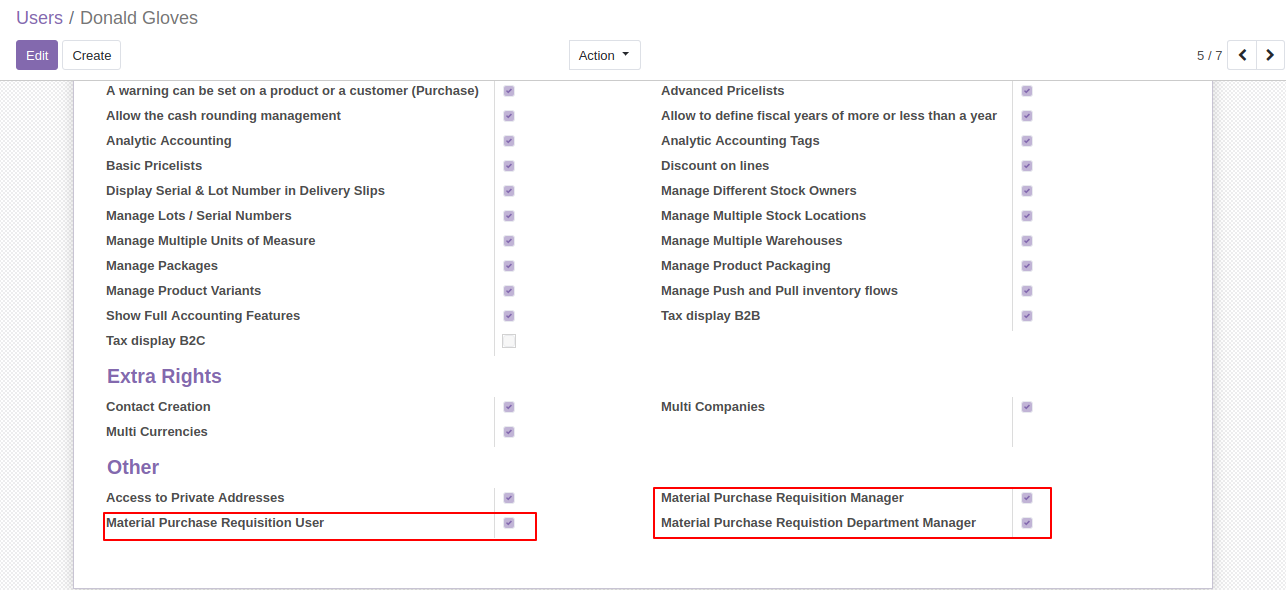
Employee Stock Location on Employee Form

Department Stock Location on Department Form

Requisition Action Options
1.Purchase Order
2.Internal Picking

Employee Create Request for Material Purchase Requisition
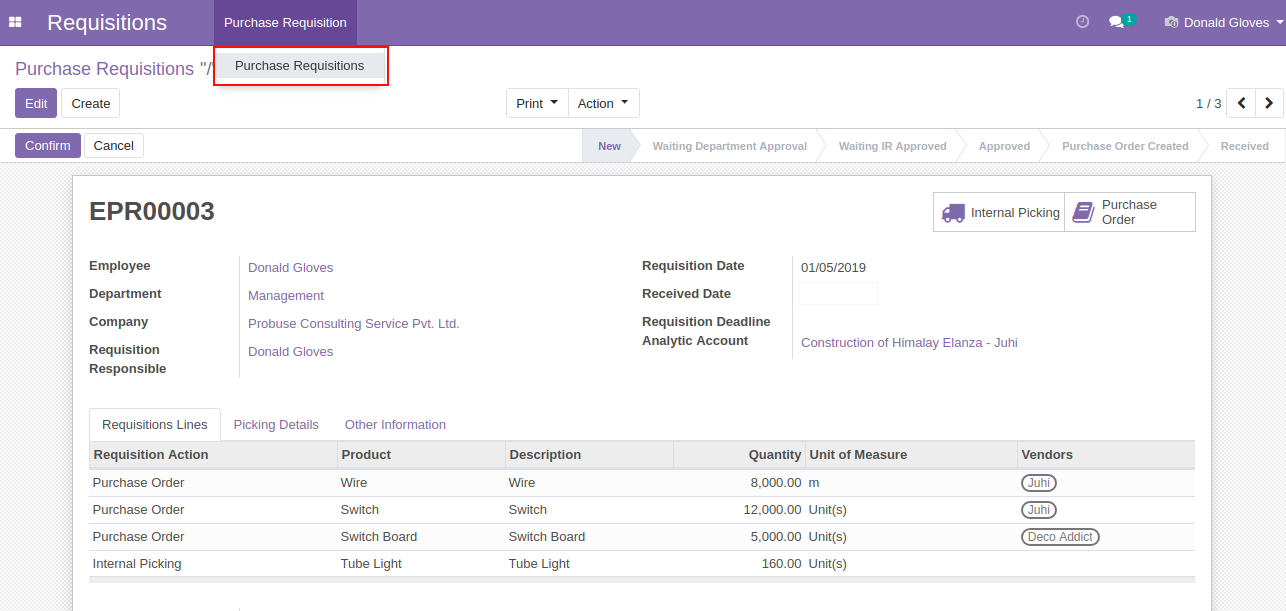
Picking Details tab

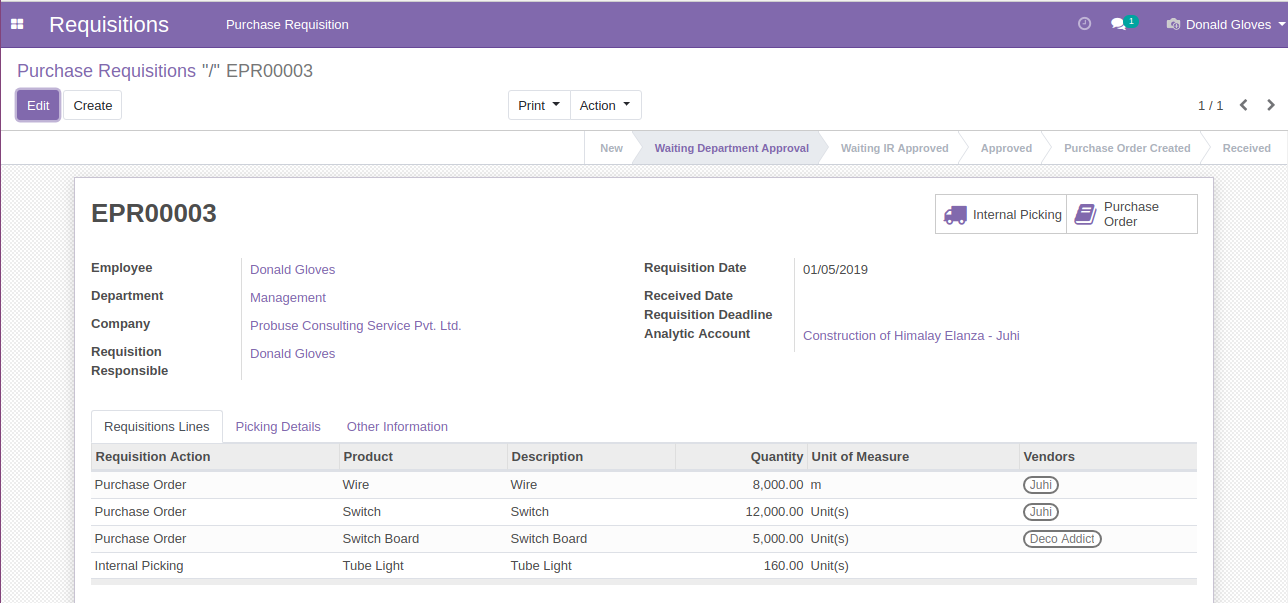
Material Purchase Requisition Waiting for Department Approval
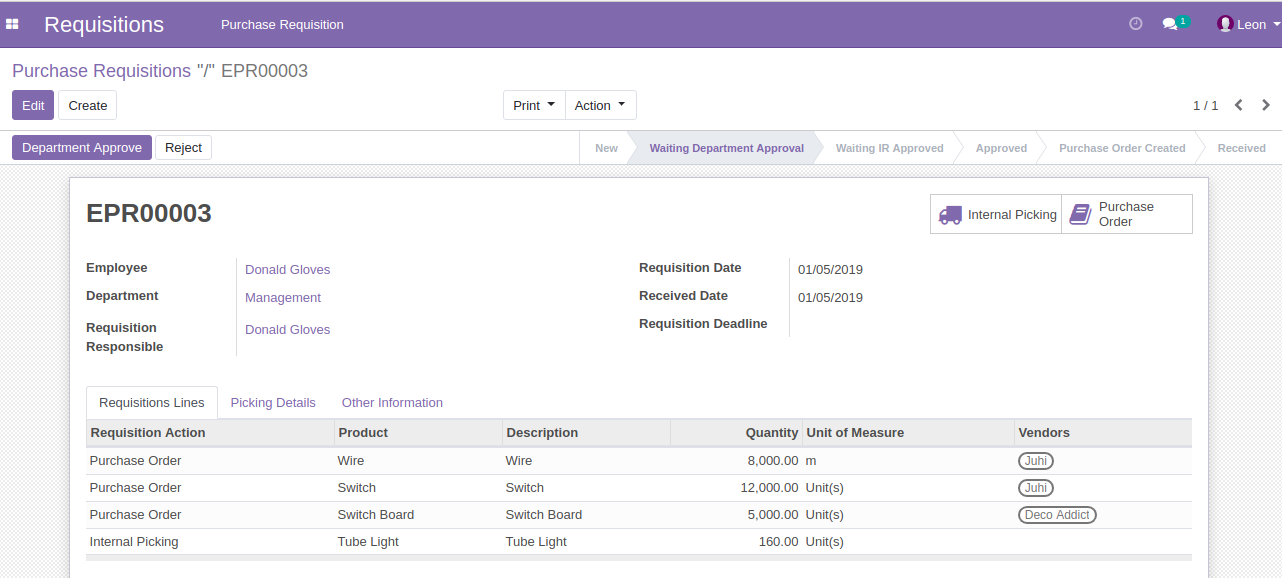
Department Manager Approve Material Purchase Requisition Request
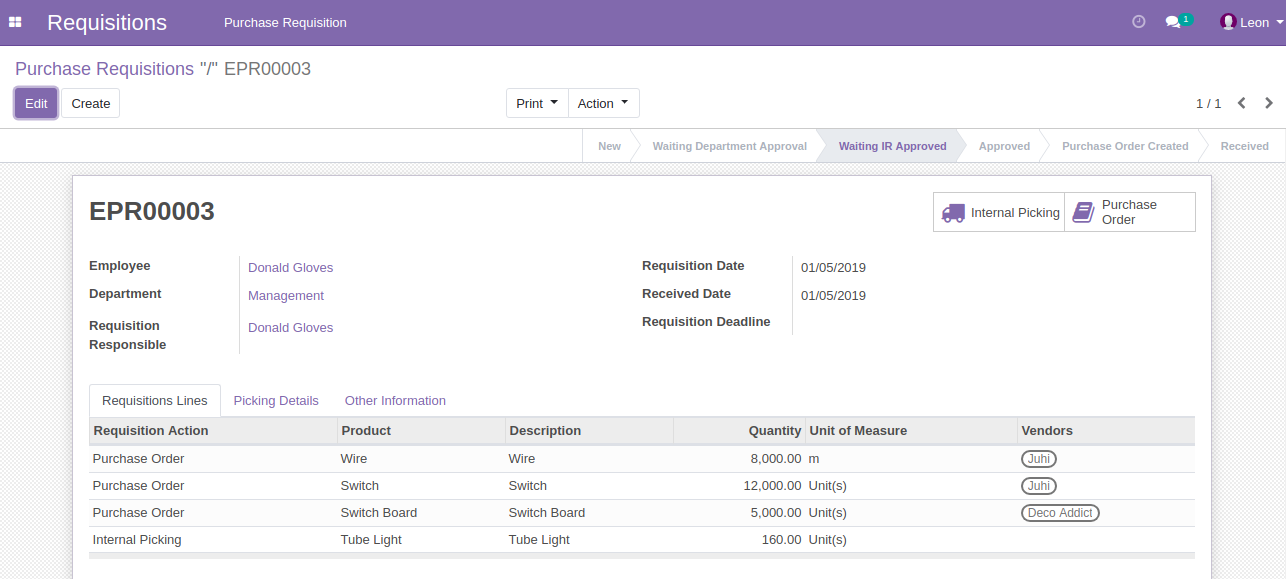
Material Purchase Requisition User Approve Material Purchase Requisition Request
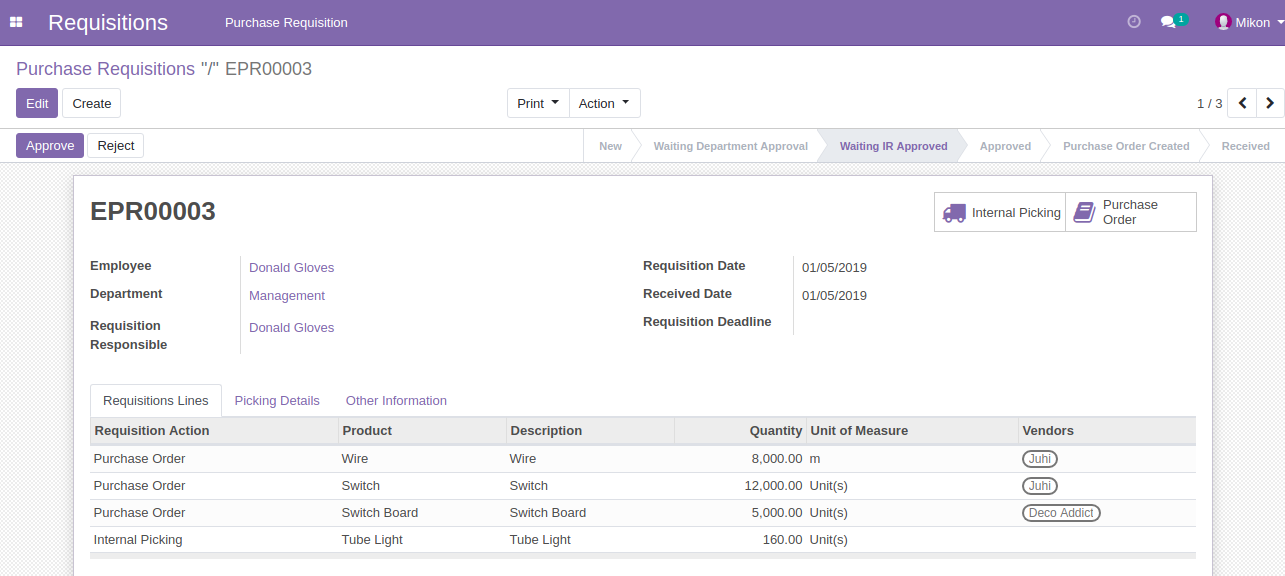
Create Picking and Purchase order based on Requisition Action
If stock is available then Purchase Requisition user can select Internal Picking in Requisition Action on Requisition line and if stock is not avialable and if they want to create purchase order they can select multiple vendors and system will create multiple RFQ's based on Vendors selected on lines.
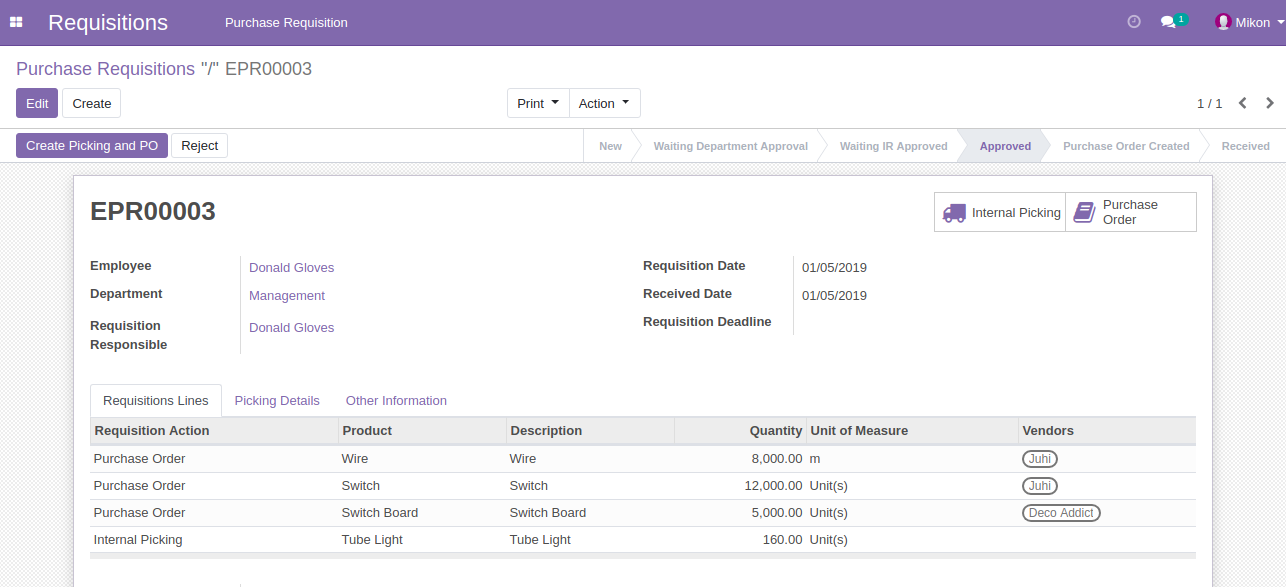
Created Internal Picking List view

Created Internal Picking Form view

Created Purchase Order List view

Created Purchase Order Form view

Created Purchase Order Form view

Received Material Purchase Requistion Button
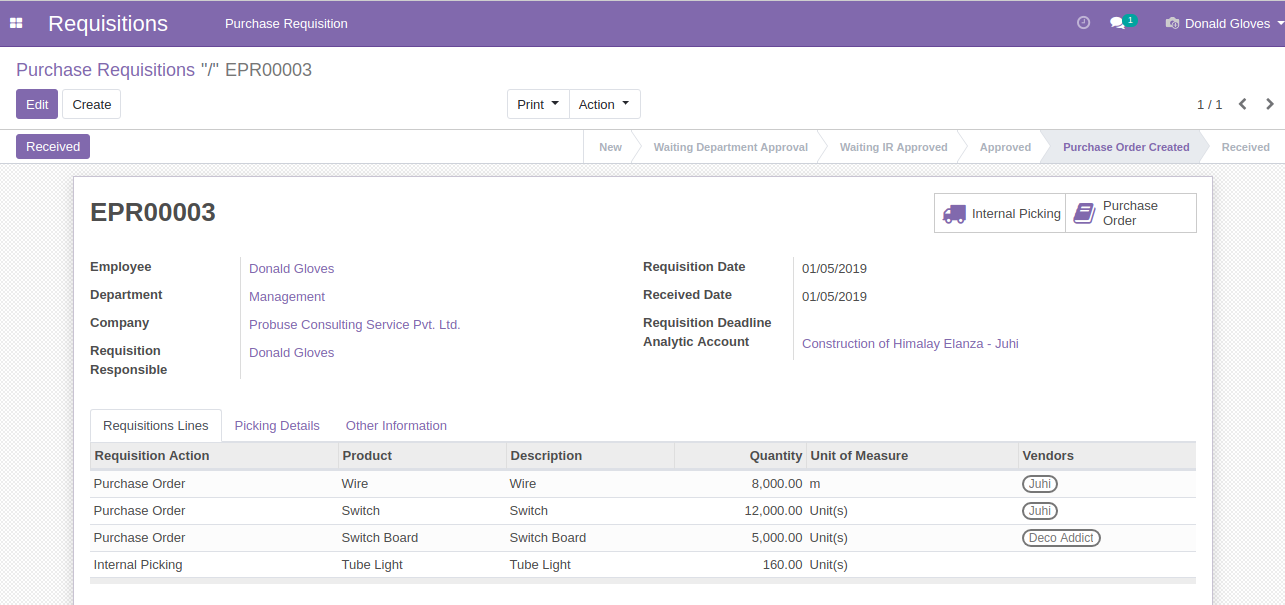
Received State on Material Purchase Requistion
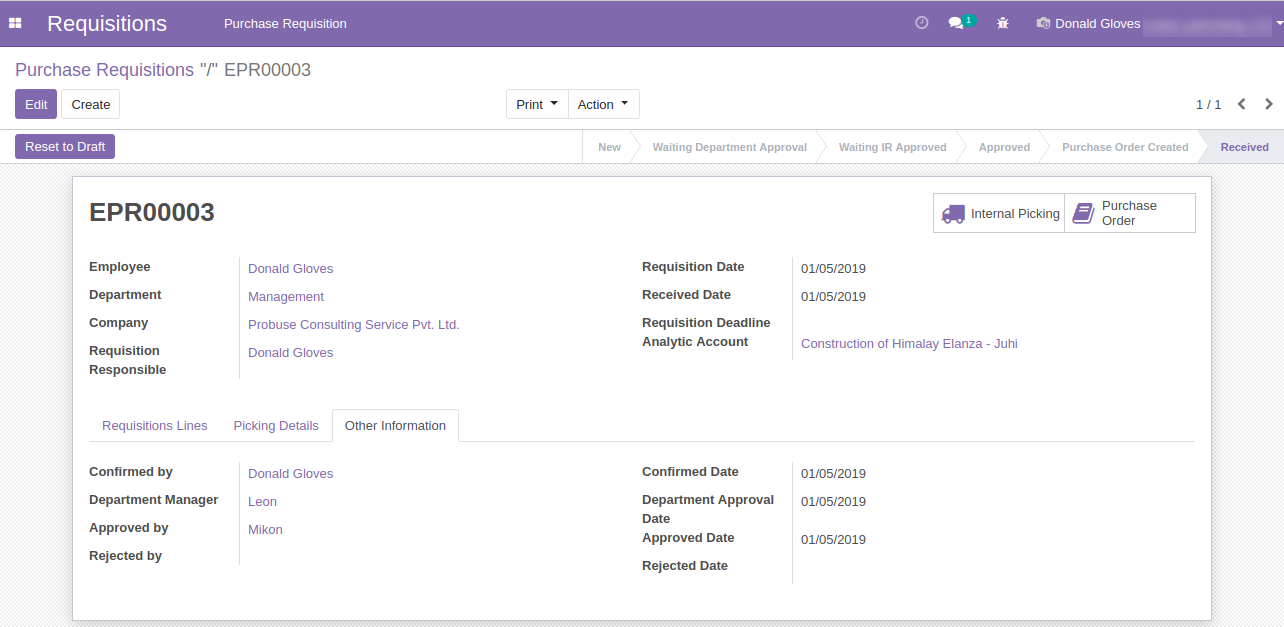
Print Material Purchase Requisition PDF Report
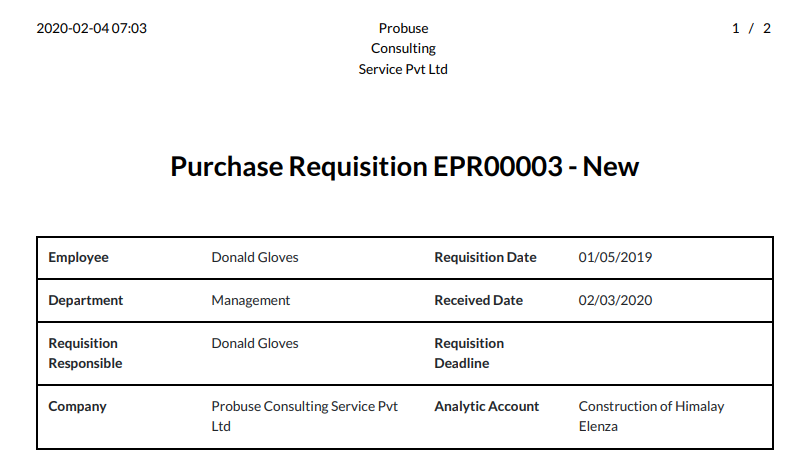
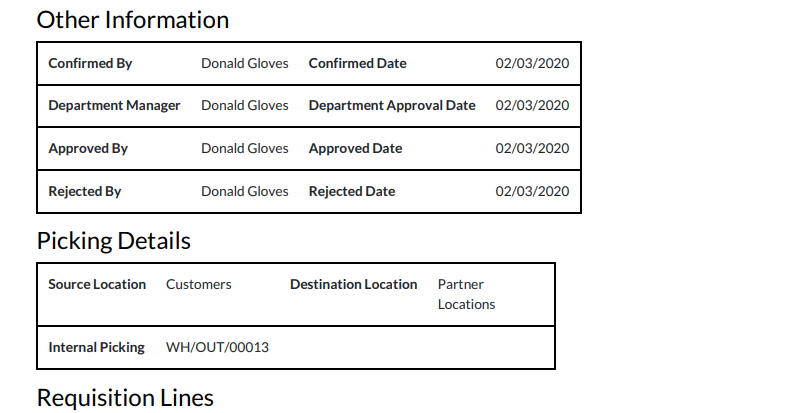
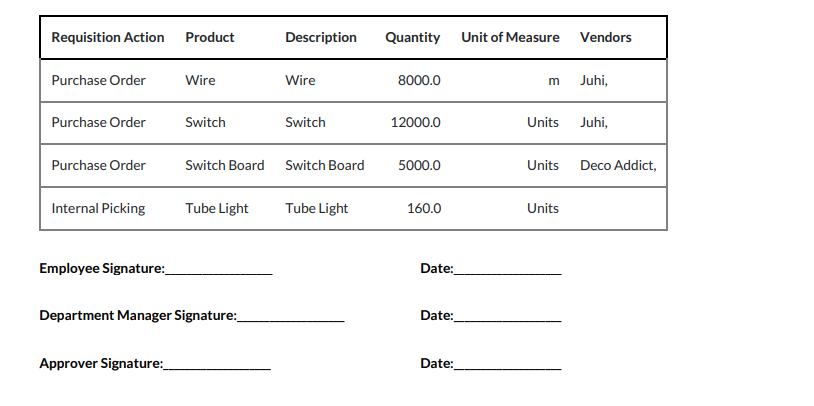
Contact / Support
Introducing
Probuse Consulting Services Pvt. Ltd.
If you need any help or want more additional features, you may contact us through:
Email: [email protected]
Website: www.probuse.com
Skype: mustufa_probuse
Probuse Consulting Service Pvt Ltd is an Software and Web development specialist which offers complete business application together. We are well experienced to provide a face for your business on the software and Internet level.
Probuse Consulting Service Pvt Ltd is a specialist in Odoo/OpenERP services and could give your business open source hand to drive.
Our Services
This is an unofficial translation of the GNU Lesser General Public License into Vietnamese. It was not published by the Free Software Foundation,
and does not legally state the distribution terms for software that uses the GNU LGPL - only the original English text of the GNU LGPL does
that. However, we hope that this translation will help language speakers understand the GNU LGPL better.
GNU LESSER GENERAL PUBLIC LICENSE
Version 3, 29 June
2007
Copyright (C) 2007 Free Software Foundation, Inc. <https://fsf.org/>
Everyone is permitted to copy and distribute verbatim copies of this license document, but changing it is not allowed.
This version of the GNU Lesser General Public License incorporates the terms and conditions of version 3 of the GNU General Public License,
supplemented by the additional permissions listed below.
0. Additional Definitions.
As used herein,"this License" refers to version 3 of the GNU Lesser General Public License, and the "GNU GPL" refers to version 3 of
the GNU "General" Public License.
"The Library" refers to a covered work governed by this License, other than an Application or a Combined Work as defined below.
An "Application" is any work that makes use of an interface provided by the Library, but which is not otherwise based on the Library.
Defining a subclass of a class defined by the Library is deemed a mode of using an interface provided by the Library.
A "Combined Work" is a work produced by combining or linking an Application with the Library. The particular version of the Library
with which the Combined Work was made is also called the "Linked Version".
The "Minimal Corresponding Source" for a Combined Work means the Corresponding Source for the Combined Work, excluding any source code
for portions of the Combined Work that, considered in isolation, are based on the Application, and not on the Linked Version.
The "Corresponding Application Code" for a Combined Work means the object code and/or source code for the Application, including any data
and utility programs needed for reproducing the Combined Work from the Application, but excluding the System Libraries of the Combined Work.
1. Exception to Section 3 of the GNU GPL.
You may convey a covered work under sections 3 and 4 of this License without being bound by section 3 of the GNU GPL.
2. Conveying Modified Versions.
If you modify a copy of the Library, and, in your modifications, a facility refers to a function or data to be supplied by an Application that
uses the facility (other than as an argument passed when the facility is invoked), then you may convey a copy of the modified version:
a) under this License, provided that you make a good faith effort to ensure that, in the event an Application does not supply the function or data, the facility still
operates, and performs whatever part of its purpose remains meaningful, or
b) under the GNU GPL, with none of the additional permissions of this License applicable to that copy.
3. Object Code Incorporating Material from Library Header Files.
The object code form of an Application may incorporate material from a header file that is part of the Library. You may convey such
object code under terms of your choice, provided that, if the incorporated material is not limited to numerical parameters, data structure
layouts and accessors, or small macros, inline functions and templates (ten or fewer lines in length), you do both of the following:
a) Give prominent notice with each copy of the object code that the Library is used in it and that the Library and its use are covered by this License.
b) Accompany the object code with a copy of the GNU GPL and this license document.
4. Combined Works.
You may convey a Combined Work under terms of your choice that, taken together, effectively do not restrict modification of the portions of the
Library contained in the Combined Work and reverse engineering for debugging such modifications, if you also do each of the following:
a) Give prominent notice with each copy of the Combined Work that the Library is used in it and that the Library and its use are covered by this License.
b) Accompany the Combined Work with a copy of the GNU GPL and this license document.
c) For a Combined Work that displays copyright notices during execution, include the copyright notice for the Library among these notices,
as well as a reference directing the user to the copies of the GNU GPL and this license document.
d) Do one of the following:
0) Convey the Minimal Corresponding Source under the terms of this License, and the Corresponding Application Code in a form suitable for, and
under terms that permit, the user to recombine or relink the Application with a modified version of the Linked Version to produce a modified
Combined Work, in the manner specified by section 6 of the GNU GPL for conveying Corresponding Source.
1) Use a suitable shared library mechanism for linking with the Library. A suitable mechanism is one that (a) uses at run time a copy of the
Library already present on the user's computer system, and (b) will operate properly with a modified version of the Library
that is interface-compatible with the Linked Version.
e) Provide Installation Information, but only if you would otherwise be required to provide such information under section 6 of the
GNU GPL, and only to the extent that such information is necessary to install and execute a modified version of the Combined Work produced by
recombining or relinking the Application with a modified version of the Linked Version. (If you use option 4d0, the Installation Information
must accompany the Minimal Corresponding Source and Corresponding Application Code. If you use option 4d1, you must provide the Installation
Information in the manner specified by section 6 of the GNU GPL for conveying Corresponding Source.)
5. Combined Libraries.
You may place library facilities that are a work based on the Library side by side in a single library together with other library facilities that
are not Applications and are not covered by this License, and convey such a combined library under terms of your choice, if you do both of
the following:
a)Accompany the combined library with a copy of the same work based on the Library, uncombined with any other library facilities,
conveyed under the terms of this License.
b) Give prominent notice with the combined library that part of it is a work based on the Library, and explaining where to find the accompanying
uncombined form of the same work.
6. Revised Versions of the GNU Lesser General Public License.
The Free Software Foundation may publish revised and/or new versions of the GNU Lesser General Public License from time to time. Such new
versions will be similar in spirit to the present version, but may differ in detail to address new problems or concerns.
Each version is given a distinguishing version number. If the Library as you received it specifies that a certain numbered
version of the GNU Lesser General Public License "or any later version" applies to it, you have the option of following the terms and
conditions either of that published version or of any later version published by the Free Software Foundation. If the Library as you
received it does not specify a version number of the GNU Lesser General Public License, you may choose any version of the GNU Lesser
General Public License ever published by the Free Software Foundation.
If the Library as you received it specifies that a proxy can decide whether future versions of the GNU Lesser General Public License shall
apply, that proxy's public statement of acceptance of any version is permanent authorization for you to choose that version for the Library.
